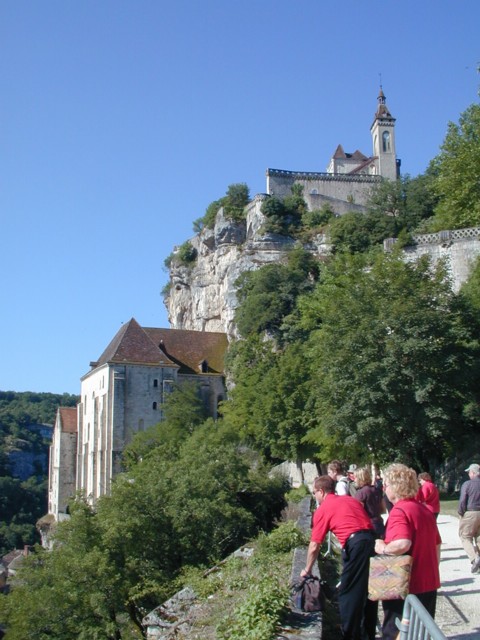

Another busy and very interesting day! In the morning we rode a short distance from Sarlat to Rocamadour; this is a small medieval town built into the side of a cliff (they have a website, though with text only in French) that is an important pilgrimage site. There is a local poem that describes the town: "the houses on the stream, the church on the houses, the rocks on the church, and the castle on the rocks." We approached from the top level, then immediately went down to the Sanctuary level below (using a funicular) to prepare for an informal concert before Mass and then to participate in the Mass.
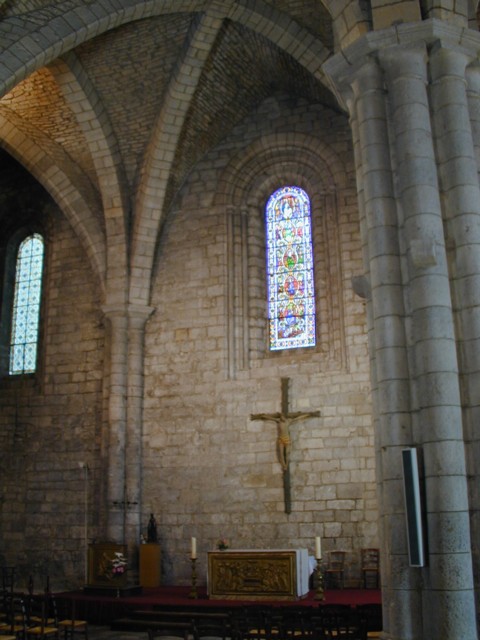
We sang before Mass lined up in front of the altar of St. Sauveur Basilica, the largest of the several churches and chapels on the middle level of Rocamadour. The small image next to the pillar in the left of the photo is a copy of Our Lady of Rocamadour, with the original in the Chapel of Our Lady next door. The twelfth-century wooden carving is in the same "Black Madonna" tradition as the "Moreneta" of Montserrat. Again, nobody knows why this tradition evolved; here our local guide suggested it had to do with an attempt during the early spread of Christianity to help pagans understand Mary's importance: in some old religions the color black was associated with fertility and mother goddesses.
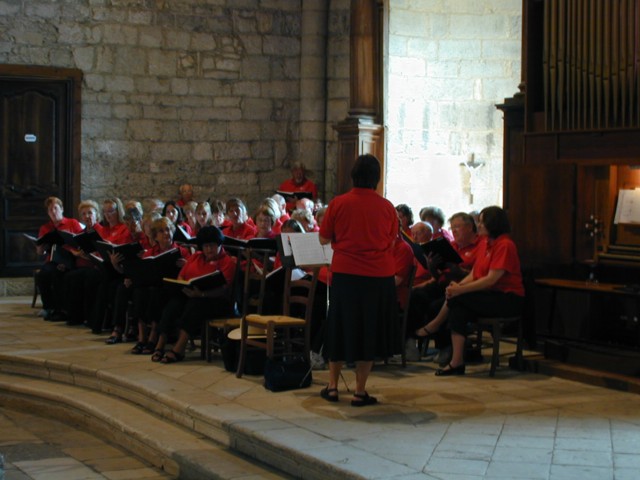
Then we sat over to the side next to the organ, while five priests celebrated Mass. We sang an introductory anthem, an offertory, a communion anthem, and a closing anthem. The priest welcomed us in English through one of our escorts as a translator, but the Mass was of course in French; however, there were a couple of litanies where a verse or prayer would be followed by either "Alleluia" or "Ave Maria," and we soon picked up the tunes and joined in (we already knew the words!). The church doors were open during the concert (which made a couple songs a bit difficult, as the bells began to ring!) and birds were flying in and out; after the doors were closed for Mass, at least one was still keeping us company inside. (Once again, many thanks to Steve Campbell for manning my camera while I sang.)
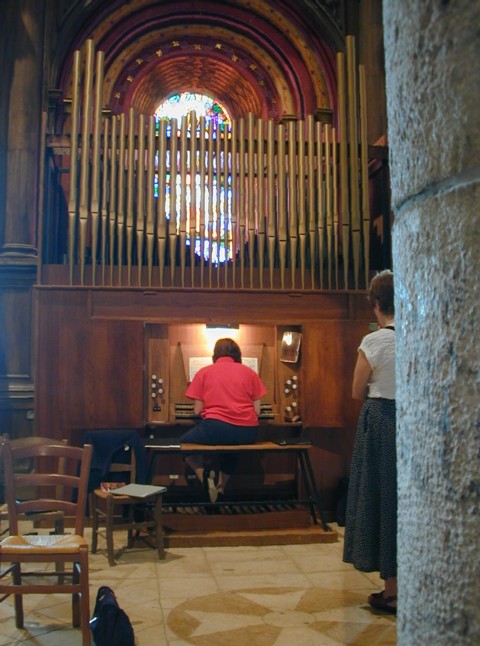
We sang both a capella and accompanied by Lee on the organ; afterward she played Bach's C minor Prelude (one of my favorites).
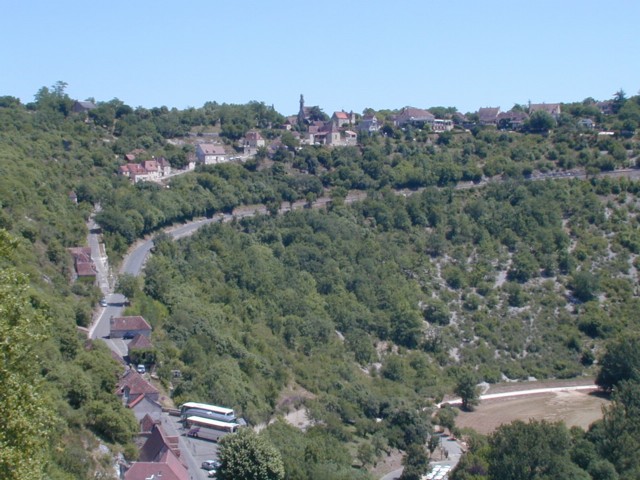
Then we went back up to the top level to drop our music off at the buses (and in many cases to change into more comfortable clothing or shoes!), and to meet local guides at the castle for a tour. Actually, the "castle" never actually had that function; rather, it was originally a simple rampart to defend the top of the cliff from attackers who wanted to steal the wealth Rocamadour had earned as a pilgrimage site. Then, when more peaceful times came, it was converted into a place to welcome pilgrims and a clock tower was added. In the middle ages, pilgrims would first have arrived in the village of L'Hospitalet, shown here. They would have gone to the chapel, the tallest structure visible, to give thanks for a safe journey through wolves, robbers, mountains, and rivers; then they would have been welcomed by local people who would wash and anoint their feet. After resting and recovering for awhile, pilgrims would complete their journey by walking down the road that merges from above with the modern thoroughfare (past the tour buses), and then into the town of Rocamadour.
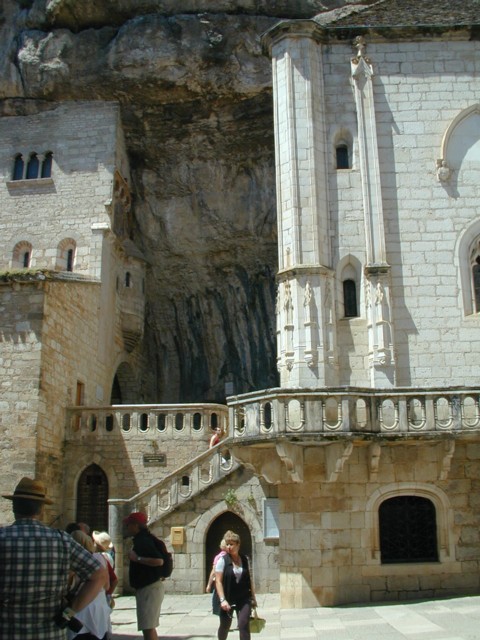
The pilgrims would then climb 216 stairs, stopping on each one to pray, to reach the Sanctuary. Here there are seven chapels; on the left in the photo is the only surviving original Romanesque chapel, that of St. Michael, and to the right is the Chapel of Our Lady, which I mentioned above. Rocamadour was a pilgrimage site before the town was there; nobody knows why, but local people would come to a particular cave here (out of many in the area) to pray to the Virgin Mary. Some monks came by to form a monastery, but they decided they could serve God better by creating facilities and a sanctuary for these pilgrims.
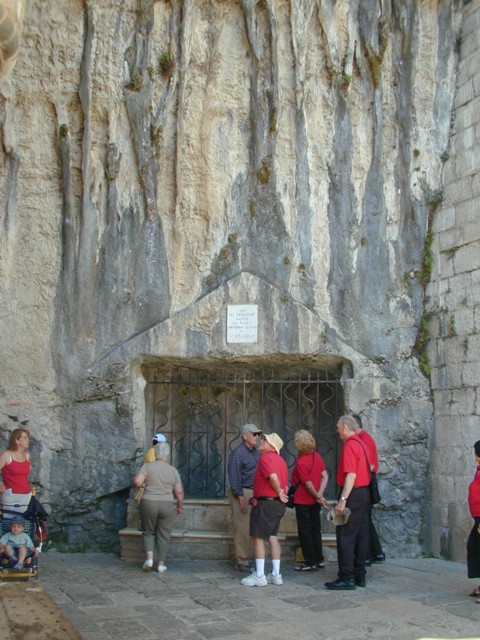
Then, as they were digging a tomb between the two chapels pictured above, the monks found a body already buried there. The plaque above the grating in this photo says (approximately) "here in 1166, perfectly preserved, was discovered the body of St. Amadour." In medieval tradition saints were thought to have the power to prevent the decomposition of their remains, so the remarkable condition of the corpse led them to conclude that they had found the relics of a saint. I saw the name of the town spelled in a couple of places as "Roc-Amadour," the Rock of Amadour; he was identified as an early Christian hermit who lived in the area, though some conclude the body was that of one of the earliest monks who began the sanctuary. There are numerous other traditions and legends here; above and to the right of this photo is a sword stuck in a cleft in the rock, which legend says is Durandal, the sword of Roland. Roland, the most famous of the knights of Charlemagne, was killed in the Pyrenees; according to the legend, to prevent his sword from being captured by the enemy, he flung it into the sky, and it came down here. On a less secular note, there is a bell in the Chapel of Our Lady, which is said to ring by itself whenever the Virgin intercedes and saves the life of a mariner at sea.
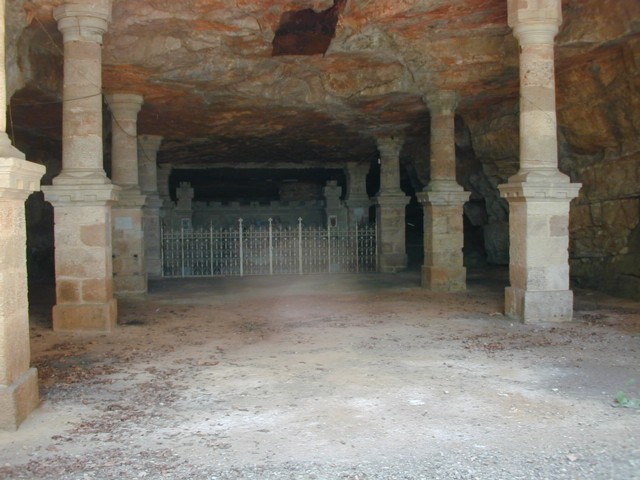
The Enlightenment led to a decline in religious fervor and enthusiasm for pilgrimages, and around the 16th century pilgrims stopped coming to Rocamadour. A rockfall destroyed the Chapel of our Lady, and all the other chapels except that of St. Michael were disassembled by local people in order to reuse the stone. Then, in the aftermath of the Franco-Prussian War in the late 19th century, there was a religious revival, which included the start of pilgrimages to Lourdes. The people of Rocamadour decided it would be a good time for the rebirth of their own pilgrimage site, and they dug stone from this quarry to rebuild the Sanctuary level above the town. They also constructed a path with the twelve Stations of the Cross, a Catholic tradition commemorating the events of Jesus' crucifixion and burial. Here at the back of this man-made cave they placed figures depicting the final Station, the Entombment.
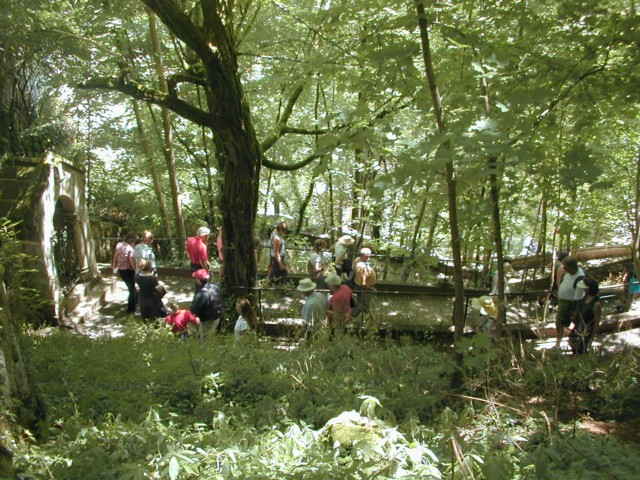
The path of the Stations of the Cross switchbacks up the side of the cliff, with a small chapel for each Station at the turns. We walked down the path, which was a lot easier than the route of the pilgrims heading up! (I just realized that, by putting the history in chronological order, I got the physical order of my photos messed up; we actually walked down the path of the Stations of the Cross from the level of the "castle" to the level of the Sanctuary, and then down the 216 steps to the town.)
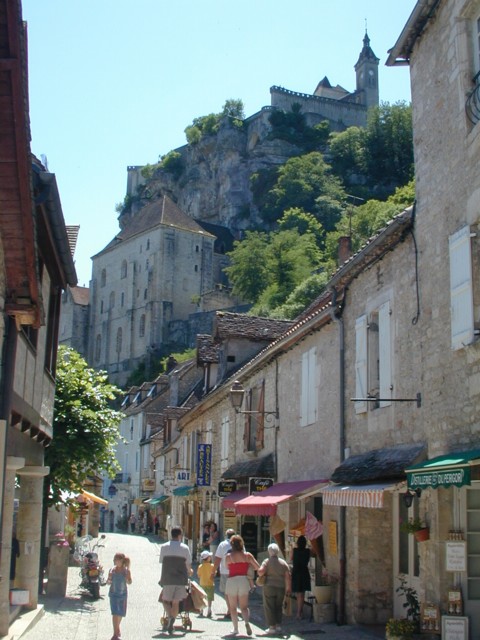
Rocamadour is a very small town, with only 600 permanent residents, but it welcomes a million visitors per year! Proportionately, that's like a smallish city of a few million people having the entire population of the world passing through it annually... There is one street, so we were told that it would be very hard to get lost, and we had a few hours there after our tour to shop and get lunch.
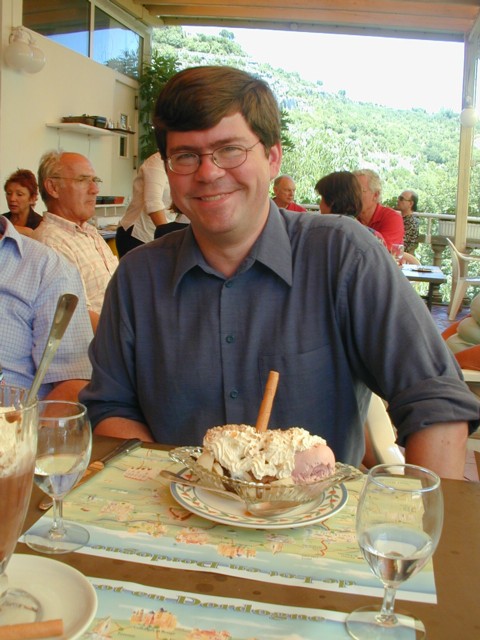
A dozen or so of us ended up at the same restaurant as I did. One of the boys of a visiting French family ordered a banana split, and after seeing it I couldn't resist getting one myself! The waitress lost track of which table had ordered it, so she ended up parading it around the dining area to a chorus of oohs and aahs (I hope that helped her sell a few more--it was delicious!). When she finally brought it to me, Carol Costello took this photo with my camera, and the others made me promise to post it on the website. Whatever merit I might have earned by going to this pilgrimage site, I kind of think I used up on this little instance of self-indulgence...
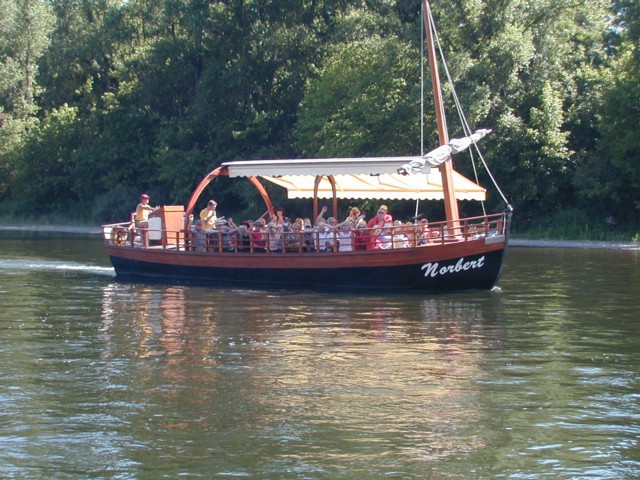
After leaving Rocamadour, we went to La Roque Gageac on the river Dordogne, and boarded two boats for a cruise down the river and back. These "gabares" are in the style of 18th-century cargo boats that plied the Dordogne. By the way, many of the towns here have names ending in "-ac" (Cognac, Bergerac, ...); this means "water," and the name of La Roque Gageac means "the rock on the water."
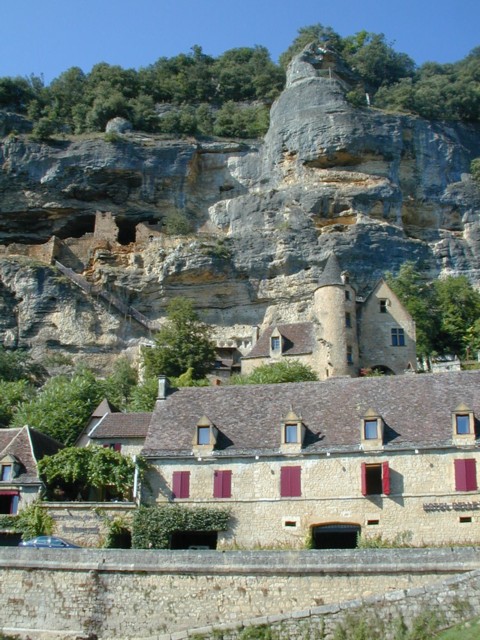
La Roque Gageac is built into the side of the cliffs, with a main street that sometimes is covered by the river in the winter. In the center of this photo is the church; according to one story, the canon in charge here during the time of Galileo was given one of the first astronomical telescopes by him! The sun on the south-facing rocks gives a lot of extra warmth to the town, so it has its own microclimate, and (for example) never freezes up in the winter. The microclimate also makes possible a garden of exotic plants just to the left of the church, including bananas, palm, bamboo, bougainvillea, and citrus (in fact, seeing palm trees on the way into town made a lot of us wonder if we'd returned home to southern California!). To the upper left of the church is a much older fort; unfortunately, the refurbished Palm IIIxe on which I'd been taking notes hard-reset itself this evening, so I don't recall exactly what century...
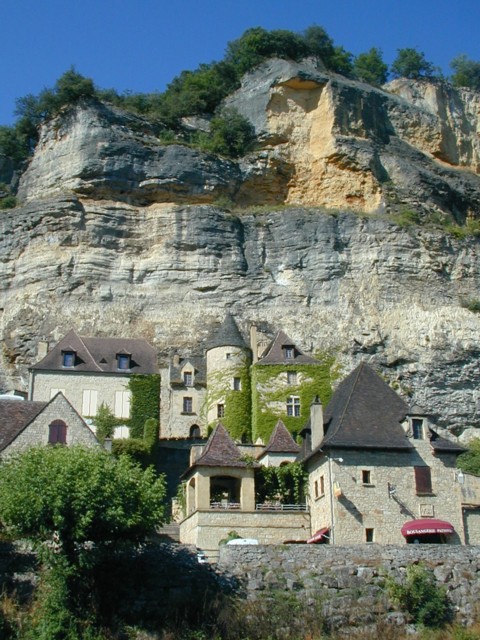
The large area of fresh-looking (more colorful) rock at the top of the cliff is the result of a rockslide in the 1950s that destroyed several houses. Fortunately, this occurred on a Sunday morning when nearly everyone was at church, so far fewer people were killed than would have been if it had happened at another time.
As we went down the river and back, we saw many of the oak trees that give this part of the Périgord region its nickname of the "black Périgord" (because the oaks keep their leaves in winter and stand out against the snow). There are also the "red" or "purple" Périgord (for the wines of Bergerac), the "white" Périgord (for its limestone), and the "green" Périgord (for the forests to the north). The region was the scene of centuries of battles between the English and the French, and from the river we saw several castles built by one side to keep an eye on the other. After we returned to Sarlat, many of us went on an evening walking tour after dinner, and some people opined that this town's medieval section is one of the prettiest they'd seen so far on this tour. I didn't go, in order to try to catch the website up to date. Also, my hotel has fast wireless Internet access, and I had brought an Apple iSight webcam just in case I ended up in a hotel with faster access than a dial-up connection, so I was actually able to see and hear my wife and daughter back home this evening! Halfway through the tour, this was particularly welcome; I wouldn't be keeping this online journal without Cheryl's willingness to let me go tomcatting around France while she keeps the home fires burning, and I miss her and little Lura greatly. Having a video chat helped restore my faith in the benefits of technology after that Palm IIIxe ate my notes!
 To
Sunday, 3 July 2005
To
Sunday, 3 July 2005 Back
to choir tour itinerary
Back
to choir tour itinerary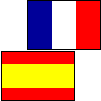 Back
to choir tour home page
Back
to choir tour home pagenew 2 July 2005